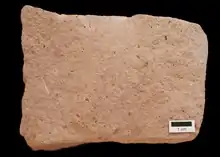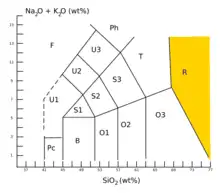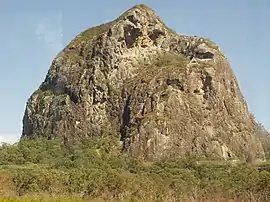Rhyolite
Rhyolite (/ˈraɪ.ə.laɪt, ˈraɪ.oʊ-/ RY-ə-lyte, RY-oh-) is the most silica-rich of volcanic rocks. It is generally glassy or fine-grained (aphanitic) in texture, but may be porphyritic, containing larger mineral crystals (phenocrysts) in an otherwise fine-grained rock. The mineral assemblage is predominantly quartz, sanidine and plagioclase. It is the extrusive equivalent to granite.
| Igneous rock | |
 | |
| Composition | |
|---|---|
| Felsic: igneous quartz and alkali feldspar (sanidine and sodic plagioclase), biotite and hornblende |
Magma with the composition of rhyolite is extremely viscous, due to its high silica content. This favors explosive eruptions over effusive eruptions, so rhyolitic magma is more often erupted as pyroclastic rock than as lava flows. Rhyolitic ash-flow tuffs are among the most voluminous of continental igneous rock formations.
Rhyolitic tuff has been extensively used for construction. Obsidian, which is rhyolitic volcanic glass, has been used for tools from prehistoric times to the present day because it can be shaped to an extremely sharp edge. Rhyolitic pumice finds use as an abrasive, in concrete, and as a soil amendment.
Description


Rhyolite is an extrusive igneous rock, formed from magma rich in silica that is extruded from a vent to cool quickly on the surface rather than slowly in the subsurface. It is generally light in color due to its low content of mafic minerals, and it is typically very fine-grained (aphanitic) or glassy.[1]
An extrusive igneous rock is classified as rhyolite when quartz constitutes 20% to 60% by volume of its total content of quartz, alkali feldspar, and plagioclase (QAPF) and alkali feldspar makes up 35% to 90% of its total feldspar content. Feldspathoids are not present. This makes rhyolite the extrusive equivalent of granite. However, while the IUGS recommends classifying volcanic rocks on the basis of their mineral composition whenever possible, volcanic rocks are often glassy or so fine-grained that mineral identification is impractical. The rock must then be classified chemically based on its content of silica and alkali metal oxides (K2O plus Na2O). Rhyolite is high in silica and total alkali metal oxides, placing it in the R field of the TAS diagram.[2][3][4][5]:140–146
The alkali feldspar in rhyolites is sanidine or, less commonly, orthoclase. It is rarely anorthoclase. These feldspar minerals sometimes are present as phenocrysts. The plagioclase is usually sodium-rich (oligoclase or andesine). Cristobalite and trydimite are sometimes present along with the quartz. Biotite, augite, fayalite, and hornblende are common accessory minerals.[1]
Geology
Due to their high content of silica and low iron and magnesium contents, rhyolitic magmas form highly viscous lavas.[5]:23–26 As a result, many eruptions of rhyolite are highly explosive, and rhyolite occurs more frequently as pyroclastic rock than as lava flows.[6]:22 Rhyolitic ash flow tuffs are the only volcanic product with volumes rivaling those of flood basalts.[5]:77 Rhyolites also occur as breccias or in lava domes, volcanic plugs, and dikes.[7][8][5]:71–72 Rhyolitic lavas erupt at a relatively low temperature of 800 °C to 1000 °C, significantly cooler than basaltic lavas, which typically erupt at temperatures of 1100 °C to 1200 °C.[5]:20
Rhyolites that cool too quickly to grow crystals form a natural glass or vitrophyre, also called obsidian.[9] Slower cooling forms microscopic crystals in the lava and results in textures such as flow foliations, spherulitic, nodular, and lithophysal structures. Some rhyolite is highly vesicular pumice.[1]
Eruptions of rhyolite are relatively rare compared to eruptions of less felsic lavas. Only four eruptions of rhyolite have been recorded since the start of the 20th century: at the St. Andrew Strait volcano in Papua New Guinea and Novarupta volcano in Alaska as well as at Chaiten and Cordon Caulle volcanoes in southern Chile.[10][11] The eruption of Novarupta in 1912 was the largest volcanic eruption of the 20th century,[12] and began with explosive volcanism that later transitioned to effusive volcanism and the formation of a rhyolite dome in the vent.[13]
Petrogenesis
Rhyolite magmas can be produced by igneous differentiation of a more mafic (silica-poor) magma, through fractional crystallization or by assimilation of melted crustal rock (anatexis). Associations of andesites, dacites, and rhyolites in similar tectonic settings and with similar chemistry suggests that the rhyolite members were formed by differentiation of mantle-derived basaltic magmas at shallow depths. In other cases, the rhyolite appears to be a product of melting of crustal sedimentary rock.[6]:21 Water vapor plays an important role in lowering the melting point of silicic rock,[6]:43 and some rhyolitic magmas may have a water content as high as 7–8 weight percent.[14][15]:44
Occurrence
Rhyolite has been found on islands far from land, but such oceanic occurrences are rare.[16]
Europe
.jpg.webp)
- Copper Coast Geopark in southeast Ireland
- Etsch Valley Vulcanite Group near Bolzano
- Gréixer rhyolitic complex at Moixeró range (Catalonia, Spain)[17]
- Iceland:[18] e.g. Torfajökull, Leirhnjúkur / Krafla, Breiddalur central volcano
- Massif de l'Esterel, France[19]
- Papa Stour in Shetland[20]
- Santorini, Greece[21]
- Snowdonia, Wales
- Vosges
Germany

- Black Forest e.g. on the Karlsruher Grat
- Odenwald
- Saxony, especially the north west
- Saar-Nahe Basin e.g. Donnersberg mountain
- Saxony-Anhalt north of Halle
- The Thuringian Forest consists mainly of rhyolites, latites and pyroclastic rocks
North America

- Bruneau-Jarbidge caldera
- Cascade Range[22]
- Castle Rock, Colorado
- Cobalt, Ontario[23]
- Crater Lake, Oregon[16]
- Jemez Mountains
- Mono-Inyo Craters
- Mount Jasper, Berlin, New Hampshire
- Mount Kineo, a volcanic plug; an iconic mountain feature located in Moosehead Lake, Rockwood, Maine
- Palisade Head, a formation found at Tettegouche State Park, Minnesota
- Rhyolite, Nevada was named after a rhyolite deposit that characterises the area.[24]
- San Juan volcanic field[25]
- St. Francois Mountains
- Wichita Mountains within the Southern Oklahoma Aulacogen
- Yellowstone
Oceania

- The Flinders Peak Group and the Teviot Range in the Fassifern Valley of Queensland, Australia is a rhyolite
- Glass House Mountains National Park, Queensland, Australia
- The Gondwana Rainforests of Australia World Heritage Area contains rhyolite-restricted flora along the Great Dividing Range.
- The Taupo Volcanic Zone in New Zealand has a large concentration of rhyolite volcanoes.
Asia
- Changbaishan, China,[27] also known as Baitoushan and Tianchi in China, and Baegdu or P'aektu-san (Paektusan) volcano in Korean.
- Malani Igneous Suite, Rajasthan, India
- Tambora, Indonesia[16]
- Yandang Mountains[28] near the town of Wenzhou, Zhejiang province, China
Africa
Antarctica
- Marie Byrd Land volcanic province[29]
Name
The name rhyolite was introduced into geology in 1860 by the German traveler and geologist Ferdinand von Richthofen[30][31][32] from the Greek word rhýax ("a stream of lava")[33] and the rock name suffix "-lite".[34]
Uses
In North American pre-historic times, rhyolite was quarried extensively in eastern Pennsylvania in the United States. Among the leading quarries was the Carbaugh Run Rhyolite Quarry Site in Adams County. Rhyolite was mined there starting 11,500 years ago.[35] Tons of rhyolite were traded across the Delmarva Peninsula,[35] because the rhyolite kept a sharp point when knapped and was used to make spear points and arrowheads.[36]
Obsidian is usually of rhyolitic composition, and it has been used for tools since prehistoric times.[37] Obsidian scalpels have been investigated for use in delicate surgery.[38] Pumice, also typically of rhyolitic composition, finds important uses as an abrasive, in concrete,[39] and as a soil amendment.[40] Rhyolitic tuff was used extensively for construction in ancient Rome[41] and has been used in construction in modern Europe.[15]:138
See also
- Bimodal volcanism – The eruption of both mafic and felsic lavas from a single volcanic centre
- Comendite – A hard, peralkaline igneous rock, a type of light blue grey rhyolite
- List of rock types – A list of rock types recognized by geologists
- Pantellerite – A peralkaline rhyolite type of volcanic rock
- Thunderegg – A nodule-like rock, that is formed within rhyolitic volcanic ash layers
References
- Blatt, Harvey; Tracy, Robert J. (1996). Petrology : igneous, sedimentary, and metamorphic (2nd ed.). New York: W.H. Freeman. pp. 55, 74. ISBN 0716724383.
- Le Bas, M. J.; Streckeisen, A. L. (1991). "The IUGS systematics of igneous rocks". Journal of the Geological Society. 148 (5): 825–833. Bibcode:1991JGSoc.148..825L. CiteSeerX 10.1.1.692.4446. doi:10.1144/gsjgs.148.5.0825. S2CID 28548230.
- "Rock Classification Scheme - Vol 1 - Igneous" (PDF). British Geological Survey: Rock Classification Scheme. 1: 1–52. 1999.
- "CLASSIFICATION OF IGNEOUS ROCKS". Archived from the original on 30 September 2011.
- Philpotts, Anthony R.; Ague, Jay J. (2009). Principles of igneous and metamorphic petrology (2nd ed.). Cambridge, UK: Cambridge University Press. ISBN 9780521880060.
- Fisher, Richard V.; Schmincke, H.-U. (1984). Pyroclastic rocks. Berlin: Springer-Verlag. ISBN 3540127569.
- Hanson, Richard E.; Schweickert, Richard A. (1 November 1982). "Chilling and Brecciation of a Devonian Rhyolite Sill Intruded into Wet Sediments, Northern Sierra Nevada, California". The Journal of Geology. 90 (6): 717–724. Bibcode:1982JG.....90..717H. doi:10.1086/628726. S2CID 128948336.
- Spell, Terry L.; Kyle, Philip R. (1989). "Petrogenesis of Valle Grande Member rhyolites, Valles Caldera, New Mexico: Implications for evolution of the Jemez Mountains Mgmatic System". Journal of Geophysical Research: Solid Earth. 94 (B8): 10379–10396. Bibcode:1989JGR....9410379S. doi:10.1029/JB094iB08p10379.
- Raymond, Loren A. (1997). Petrology : the study of igneous, sedimentary, metamorphic rocks (Complete customized version ed.). Dubuque, IA: McGraw-Hill Companies, Inc. p. 27. ISBN 0697413403.
- Wilson, C.J. (2011). Insights Into the Workings of Rhyolitic Explosive Eruptions and Their Magmatic Sources. American Geophysical Union Fall Meeting 2011. AGU Fall Meeting Abstracts. 2011. American Geophysical Union. pp. V42A–01. Bibcode:2011AGUFM.V42A..01W. abstract id. V42A-01. Retrieved 27 October 2020.
- Magnall, N.; James, M.R.; Tuffen, H.; Vye-Brown, C. (2017). "Emplacing a Cooling-Limited Rhyolite Lava Flow: Similarities with Basaltic Lava Flows". Frontiers in Earth Science. 5: 44. Bibcode:2017FrEaS...5...44M. doi:10.3389/feart.2017.00044. S2CID 12887930.
- Fierstein, Judy; Hildreth, Wes; Hendley, James W. II; Stauffer, Peter H. (1998). "Can Another Great Volcanic Eruption Happen in Alaska? – U.S. Geological Survey Fact Sheet 075-98". Version 1.0. United States Geological Survey. Retrieved September 10, 2008. Cite journal requires
|journal=(help) - Nguyen, Chinh T.; Gonnermann, Helge M.; Houghton, Bruce F. (August 2014). "Explosive to effusive transition during the largest volcanic eruption of the 20th century (Novarupta 1912, Alaska)". Geology. 42 (8): 703–706. Bibcode:2014Geo....42..703N. doi:10.1130/G35593.1.
- Ewart, A.; Hildreth, W.; Carmichael, I. S. E. (1 March 1975). "Quaternary acid magma in New Zealand". Contributions to Mineralogy and Petrology. 51 (1): 1–27. Bibcode:1975CoMP...51....1E. doi:10.1007/BF00403509. S2CID 129102186.
- Schmincke, Hans-Ulrich (2003). Volcanism. Berlin: Springer. ISBN 9783540436508.
- Farndon, John (2007) The Illustrated Encyclopedia of Rocks of the World. Southwater. p. 54. ISBN 1844762696
- Martí, J.; Aguirre-Díaz, G.J., and Geyer, A. (2010). "The Gréixer rhyolitic complex (Catalan Pyrenees): an example of Permian caldera". Workshop on Collapse Calderas – La Réunion. IAVCEI – Commission on Collapse Calderas.
- Berg, Sylvia E.; Troll, Valentin R.; Harris, Chris; Deegan, Frances M.; Riishuus, Morten S.; Burchardt, Steffi; Krumbholz, Michael (October 2018). "Exceptionally high whole-rock δ18O values in intra-caldera rhyolites from Northeast Iceland". Mineralogical Magazine. 82 (5): 1147–1168. Bibcode:2018MinM...82.1147B. doi:10.1180/mgm.2018.114. ISSN 0026-461X.
- Poitrasson, F.; Pin, C. (1998). "Extreme Nd isotope homogeneity in a large rhyolitic province: the Estérel massif, southeast France". Bulletin of Volcanology. 60 (3): 213–223. Bibcode:1998BVol...60..213P. doi:10.1007/s004450050228. S2CID 129024115.
- "Papa Stour Volcanic Formation". The BGS Lexicon of Named Rock Units. British Geological Survey. Retrieved 28 October 2020.
- Mortazavi, M.; Sparks, R.S.J. (2004). "Origin of rhyolite and rhyodacite lavas and associated mafic inclusions of Cape Akrotiri, Santorini: the role of wet basalt in generating calcalkaline silicic magmas". Contributions to Mineralogy and Petrology. 146 (4): 397–413. Bibcode:2004CoMP..146..397M. doi:10.1007/s00410-003-0508-4. S2CID 129739700.
- Cascades Volcano Observatory. "Cascades Volcano Observatory". usgs.gov. Retrieved 19 January 2015.
- Cinits, Robert (1986). "The Proteus Property" (PDF). Ministry of Energy, Northern Development and Mines, Ontario, Canada.
- "Rhyolite Ghost Town". Retrieved 2009-12-22.
- Lipman, P.W. (1987). Rare-Earth-Element Compositions of Cenozoic Volcanic Rocks in the Southern Rocky Mountains and Adjacent Areas (USGS Bulletin 1668) (PDF). Washington D.C.: USGS. p. 4.
- Jenks, W.F.; Goldich, S.S. (1956). "Rhyolitic Tuff Flows in Southern Peru". The Journal of Geology. 64 (2): 156–172. Bibcode:1956JG.....64..156J. doi:10.1086/626331. S2CID 129139823.
- "Changbaishan volcano". Volcano Discovery.
- "Yandang Shan". Archived from the original on 2016-02-17. Retrieved 2011-12-22.
- LeMasurier, W.E.; Futa, K.; Hole, M.; Kawachi, Y. (2003). "Polybaric Evolution of Phonolite, Trachyte, and Rhyolite Volcanoes in Eastern Marie Byrd Land, Antarctica: Controls on Peralkalinity and Silica Saturation". International Geology Review. 45 (12): 1055–1099. Bibcode:2003IGRv...45.1055L. doi:10.2747/0020-6814.45.12.1055. S2CID 130450918.
- Richthofen, Ferdinand Freiherrn von (1860). "Studien aus den ungarisch-siebenbürgischen Trachytgebirgen" [Studies of the trachyte mountains of Hungarian Transylvania]. Jahrbuch der Kaiserlich-Königlichen Geologischen Reichsanstalt (Wein) [Annals of the Imperial-Royal Geological Institute of Vienna] (in German). 11: 153–273.
- Simpson, John A.; Weiner, Edmund S. C., eds. (1989). Oxford English Dictionary. 13 (2nd ed.). Oxford: Oxford University Press. p. 873.
- Young, Davis A. (2003). Mind Over Magma: The Story of Igneous Petrology. Princeton University Press. p. 117. ISBN 0-691-10279-1.
- "Definition of RHYOLITE". www.merriam-webster.com.
- "Definition of LITE". www.merriam-webster.com.
- Fergus, Charles (2001). Natural Pennsylvania: Exploring the State Forest Natural Areas. Stackpole Books. p. 30. OCLC 47018498.
- Bricker, Dakota. "Snaggy Ridge Indian Rhyolite Quarries". Mercersburg Historical Society. Retrieved 2019-01-20.
- Cotterell, Brian; Kamminga, Johan (1992). Mechanics of pre-industrial technology: an introduction to the mechanics of ancient and traditional material culture. Cambridge University Press. pp. 127–. ISBN 978-0-521-42871-2. Retrieved 9 September 2011.
- Buck, BA (March 1982). "Ancient Technology in Contemporary Surgery". The Western Journal of Medicine. 136 (3): 265–269. PMC 1273673. PMID 7046256.
- Grasser, Klaus (1990). Building with Pumice (PDF). Deutsche Gesellschaft für Technische Zusammenarbeit (GTZ). p. 64. ISBN 3-528-02055-5. Retrieved 23 March 2019.
- Crangle, Robert D. Jr. (January 2012). "Pumice and pumicite – USGS Mineral Resources Program" (PDF). United States Geological Survey. Retrieved 25 November 2018.
- Jackson, M. D.; Marra, F.; Hay, R. L.; Cawood, C.; Winkler, E. M. (2005). "The Judicious Selection and Preservation of Tuff and Travertine Building Stone in Ancient Rome*". Archaeometry. 47 (3): 485–510. doi:10.1111/j.1475-4754.2005.00215.x.
External links
| Wikimedia Commons has media related to: |
